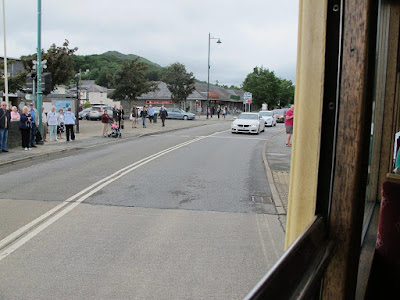If there was a fire, or in today's less settled society, a terrorist threat or actual attack on Terminal One (as that original terminal became), the Tower would have to be abandoned which would bring the Airport to a halt. The Airport's business continuity insurers would no longer accept that as an affordable risk, so a new, stand-alone Tower, was required.
Please click on any picture for a larger image.
The 1962 Tower at Manchester, atop Terminal One. A BEA Vanguard on the apron.
A couple of years ago the new Tower was built at a cost of £20M, and this afternoon I enjoyed an Interesting tour around the facility. I had visited the old tower many times but this was my first visit to the new one.
The visit was organised through my involvement with the Airport as an occasional but long standing guide on Concorde G-BOAC and ex-RAF Nimrod XV231.
The new control tower from the car park in front of the fire station.
General view to the south east from the VCR (visual Control Room) atop the tower.
In the old tower, displays were built into control desks. In the new environment, all displays are free-standing flat screens, easily swapped out in the event of a fault.
In order to reduce glare from the sun shining through the large glass panels, transparent blinds are drawn which doesn't aid photography! You can see the brighter vertical stripes between the edges of each blind, and the window frames.
In order to reduce glare from the sun shining through the large glass panels, transparent blinds are drawn which doesn't aid photography! You can see the brighter vertical stripes between the edges of each blind, and the window frames.
An aircrat waiting to cross 23R, headed for 23L for take off. It is in contact with the 23R controller, who controls that runway and any crossing traffic. Once it has crossed, it will be handed over to the 23L controller.
An aircraft vacating runway 23R (the landing runway today, 23L, visible beyond the aeroplane, just this side of the trees, being used for take offs).
Note the old road in the foreground. This is the original Altrincham - Wilmslow road, in use before the runway tunnels were built. As a lad I used to ride my bicycle along it going from my home in Sale to visit a friend in Alderley Edge. And some years ago I taxyed our Chipmunk aeroplane along it having landed on runway 24 (as 23R was back then) and parking on the grass in front of the viewing park (whose boundary fence can be seen on the right of the picture).
Manchester city centre, beyond the buildings of Terminal Two.
View over the Runway Visitor Park to the 05 thresholds. Note the open blind on the right hand window.
Jodrell Bank radio telescope on the southern horizon.
Terminal One and the old 1962 tower.
The Concorde hangar in the foreground, runway 05L threshold behind it, and 05R threshold beyond the band of trees, right down in Mobberley.
Looking towards the Fairey Hangars, and beyond, the new warehouse park on the far side of the Wilmslow road
The GPO tower on Crocker Hill between Macclesfield and Congleton on the horizon, the hill of Alderley Edge in the foreground, with the new 'Waters' building prominent just across the Bollin Valley from the airfield.
We ascended to the VCR 6 floors by lift. This is the alternative - the fire escape stairs within the 'tube' of the tower. It's a long way down!
The radar room, on the ground floor
On the ground floor is the radar room, housing Approach Control, who 'pick up' inbound aircraft at about 40 miles out and vector them onto the ILS (Instrument Landing System) for the duty runway, whereupon they are handed over to the Tower controller up in the VCR.
The chap on the right is 'Manchester Approach' (118.525 MHz), the chap on the left is 'Manchester Director' (121.35MHz) who is on duty at busy times as an 'interim' between 'Approach' and 'Tower' to sequence the arrivals onto final for 'Tower'.
The chap in the middle is about to take over 'Approach' so is 'getting the picture'.
When it's very busy, a 'Northern Approach' controller is added to these two, 'Approach' then handling only the southern arrivals.
A close up of a radar display.
The radar head is on the airfield, but can be supplemented by remote radars piped in from locations such as Clee Hill in Shropshire. The radar data is digitised and fed into a computer, which attaches relevant data to the 'returns' shown on the display.
The display shows the runway 23R centreline, the airport on the centre, and the 23L departure centreline. A Loganair departure is just turning right off 23L, and there are 4 aircraft on final for 23R.
The display shows the runway 23R centreline, the airport on the centre, and the 23L departure centreline. A Loganair departure is just turning right off 23L, and there are 4 aircraft on final for 23R.
Manchester has replaced the old paper 'flight progress strips' by this electronic version.
.































































